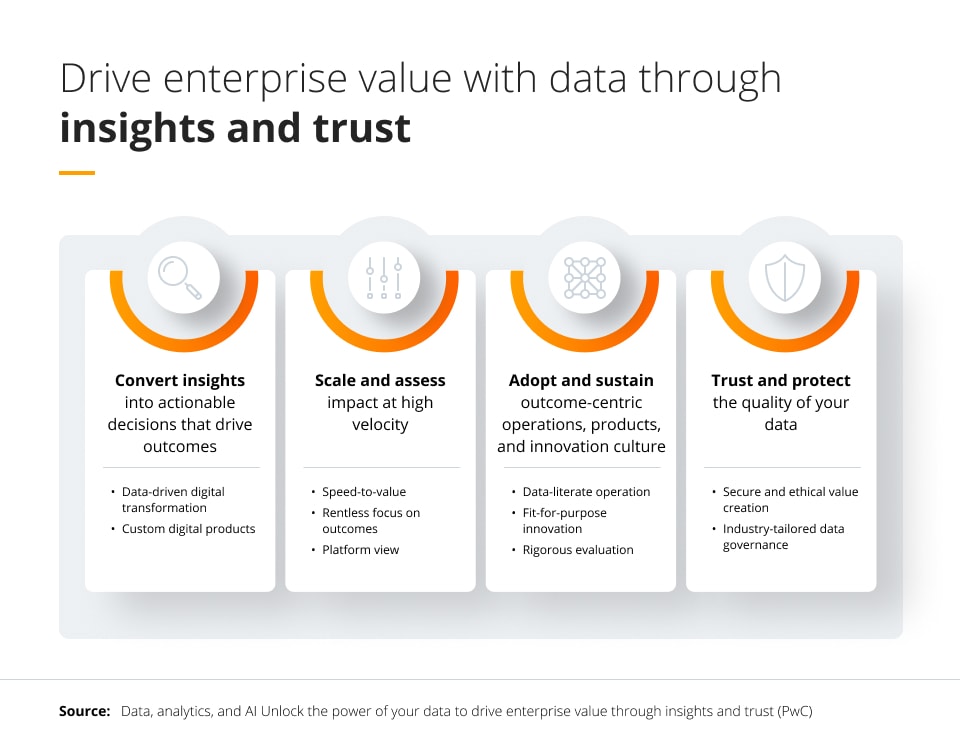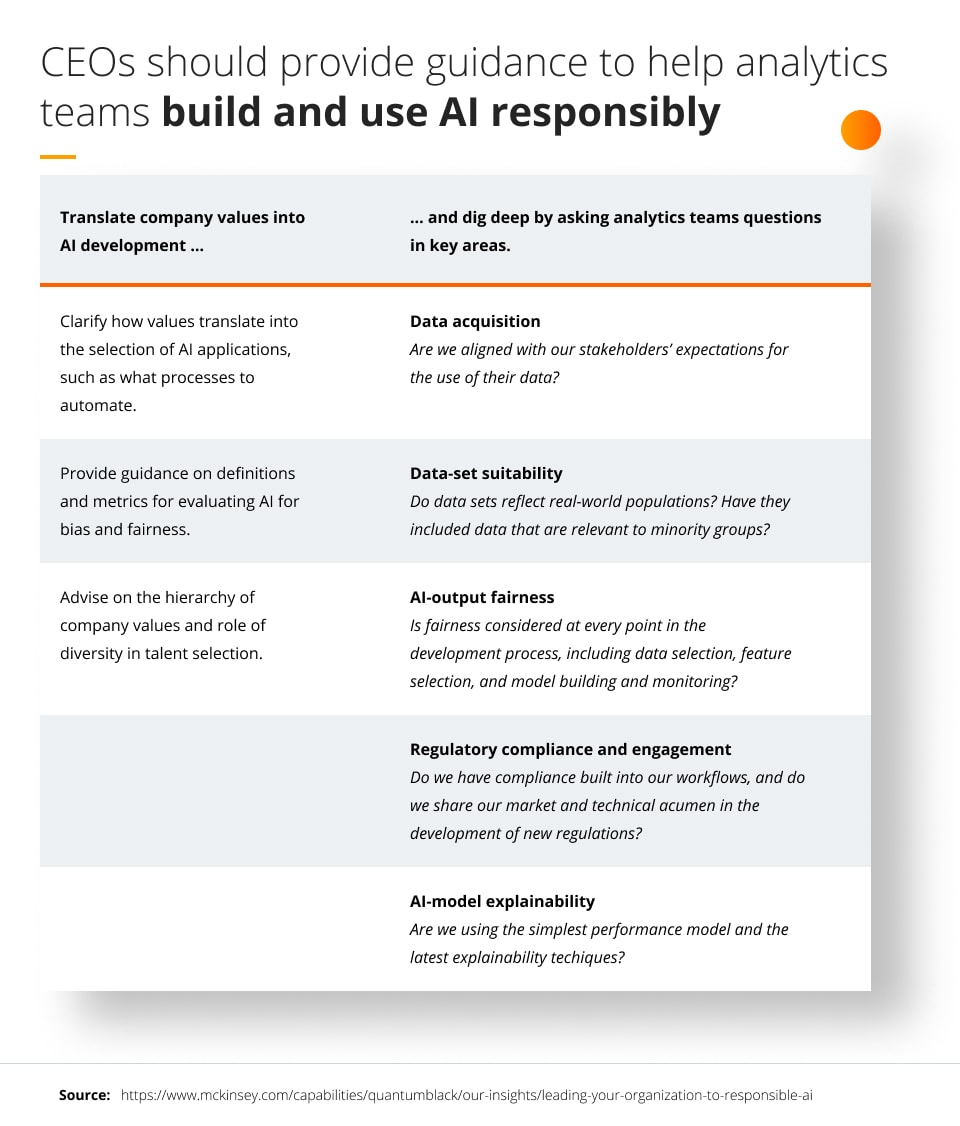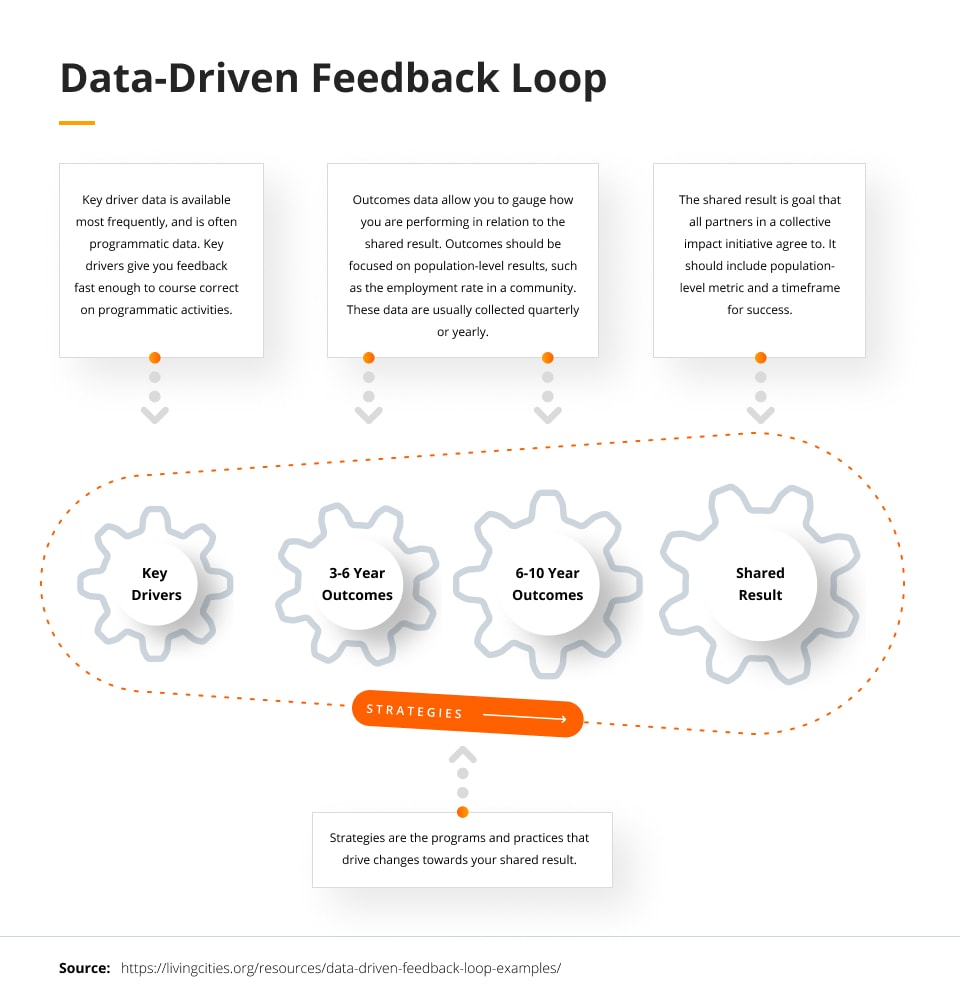
Creating a data-driven culture: a roadmap for organizational transformation
A data-driven culture is one where data is used to inform all aspects of the business, from strategic planning to day-to-day operations. In this article, you will learn about the key ingredients that leaders and execs need for successful data-driven change.
Data is more valuable than ever in today’s rapidly evolving business landscape. Organizations that effectively leverage data to make better decisions and conduct cultural transformation are better positioned to succeed.
Why a data-driven culture matters in today’s business landscape
There are many benefits to creating a data-driven and measuring company culture. Data can help organizations to:
- Make better decisions:
Data can provide insights into customer behavior, market trends, and operational performance. This information can be used to make more informed decisions about everything from product development to marketing campaigns to workforce management. For example, a company can use data to identify customer segments likely to churn and develop targeted retention strategies. - Improve efficiency and productivity:
Data can be used to identify and eliminate inefficiencies in processes and systems. It can also be used to automate tasks and streamline workflows. For example, a company can use data to identify the most time-consuming tasks in a customer service process and then develop automation solutions to simplify those tasks. According to Gartner (link), data and analytics leaders must leverage adaptive AI systems, data sharing, and data fabrics to drive growth, resilience, and innovation. - Gain a competitive advantage:
In today’s data-driven world, organizations that can effectively use data to make better decisions and improve their operations are at a competitive advantage. For example, a company can use data to identify new market opportunities or to develop new products and services that meet the needs of its customers. Speaking about market entry or go-to-market strategy, it is critical to answer how an organization’s culture affects its operations. The answer usually depends on decision-making, data literacy, communication, risk-taking, productivity, and customer satisfaction.
From instinct to insight: the paradigm shift toward data-centric decision making
Businesses have relied on gut instinct and intuition for years to make critical business decisions. However, this approach must be revised in today’s increasingly competitive and complex world. Data provides a more objective and evidence-based basis for decision-making, which can lead to better business outcomes.
The shift to data-driven decision-making requires a paradigm shift in how companies think about data. Data should be considered a valuable asset for all employees to make better decisions, not just a siloed resource used by analysts and data scientists.
To create a data-driven culture, companies need to buy into the importance of data-driven decision-making at all levels of the organization. This involves equipping employees with the necessary tools and training to effectively gather, analyze, and utilize data, enabling them to make informed decisions.
One example of how companies can create a more data-driven culture is by creating data dashboards and reports accessible to all employees. This allows employees to easily see and understand the relevant data to their work, which can help them make better decisions.
Another example is training employees on data analytics tools and techniques. This will help employees develop the skills they need to collect, analyze, and interpret data, which can lead to better decision-making.
Companies can create a more data-driven culture by making data accessible and empowering employees, improving business outcomes. It’s also important when the specific enterprise designs outsourcing processes and seeks to establish an IT outsourcing culture.
Key steps of creating a data-driven culture
There are a few key steps that organizations can take to create a data-driven culture:
Data literacy: cultivating a workforce skilled in data analysis and interpretation
The first step in creating a data-driven culture is cultivating a skilled data analysis and interpretation workforce. This means providing employees with the training and resources to understand and use data effectively. This can be done through formal training programs like DataCamp or Coursera courses, self-paced learning resources like Google Analytics Academy, and on-the-job training.
Specific training topics could include:
- Data literacy: How to read, understand, and use data effectively.
- Data storytelling: How to communicate data insights clearly and compellingly.
- Data-driven decision-making: How to use data to make better decisions.
Training could also include specific examples of how data can improve essential business decisions, such as tracking sales numbers, identifying new ideas, and optimizing processes.
Strategic alignment: ensuring data goals resonate with the overall business vision
It is essential to ensure data goals align with the overall business vision. This means identifying the critical business questions that data can be used to answer and then developing data strategies to address those questions.
Here are two examples:
- A data-driven organization might use data to identify new market opportunities or to improve customer satisfaction. For example, a retail company could use data to gather insights into customer purchasing behavior and then use those insights to develop more targeted marketing campaigns (to reduce churn and increase activation)
- A data-driven organization might use data to improve the efficiency of its business processes. For example, a manufacturing company could use data to track the flow of materials through their factory and identify areas where they can reduce waste or improve output (for instance, lower returns rate).
To achieve these goals, data-driven organizations need to:
- Gather high-quality data from various sources, including internal systems, customer surveys, and market research.
- Implement robust data culture and practices to ensure that data is collected, stored, and used responsibly and ethically.
- Use reporting software and other tools to analyze data and extract insights.
- Make decisions based on data and use those decisions to improve their business processes and outcomes.
Technology and tools: investing in the proper infrastructure for data management
To create a data-driven culture, organizations must invest in the right technology and tools, like Tableau and QlikView, to support their data-driven initiatives. This includes robust data management and solution services to track outcomes, empower decision-makers to conclude, and help the IT department integrate data sources across the company.
Here are some specific examples of how companies can use technology to track outcomes, empower decision-makers, and create a data-driven culture:
- Track outcomes: Tableau and QlikView can be used to create dashboards and reports that track key metrics, such as sales numbers, customer satisfaction, and employee productivity. This information can help decision-makers see the impact of their decisions and make adjustments as needed.
- Empower decision makers: Tech strategy consulting can and should give decision-makers the tools they need to conclude the data. This helps them to make more informed decisions and take ownership of their results.
- Create a data-driven culture: Tableau and QlikView can help to create a data-driven culture by making it easy for employees to access and understand the data. This can lead to better decision-making at all levels of the organization through data-powered discussions, brainstorming sessions, and executive meetings.
Empowerment from the top: role of leadership in building data-driven strategy
Leadership plays a critical role in building a data-driven culture. Leaders must demonstrate their commitment to informed decisions based on analytics and empower employees to use data to make better decisions.
Here are some examples of how leaders can create a data-driven culture:
- Give employees access to the correct data and tools. Employees need to access and analyze data to make informed decisions easily.
- Provide training on data analytics. Employees must know how to collect, analyze, and interpret data to draw meaningful insights.
- Encourage employees to use data to make decisions at all levels of the organization. This means creating a culture where everyone feels comfortable asking questions and challenging the status quo.
- Reward employees for making better decisions based on data. This shows that the company values data-driven decision-making and encourages employees to use data to improve their work.
When companies create a data-driven culture, employees are more likely to make better decisions that lead to positive outcomes for the business. For example, managers can use data to make better decisions about hiring, training, and developing employees.
Bridging the gap: overcoming resistance and pushback during the transition
Creating a data-driven culture can lead to better decisions for organizations. However, the transition can be challenging, as some employees may be uncomfortable using data or afraid of change.
The CIECH Group, a chemical producer based in Poland, has successfully implemented a data-driven decision-making model by transforming its management reporting. The company created a new business area under the CFO, responsible for implementing the Data and analytics strategy. This strategy has been subsequently implemented in other operational areas as well.
Of course, not all organizations are as data-driven as CIECH Group. And even in organizations that are trying to become more data-driven, there may be resistance from some employees. To address these concerns, leaders must communicate the benefits of a data-driven culture and provide employees with the support they need to transition. For example, leaders can:
- Provide training on data analysis and visualization tools. This will help employees feel more comfortable working with data.
- Encourage employees to experiment with data and share their insights. This will help to create a culture of data-driven decision-making.
- Use data to make decisions transparently. This will help employees understand how data is used and why decisions are made.
Creating synergy: integrating data departments for cohesive insights
In the era of data-driven decision-making, data departments must collaborate and provide unified insights. However, this is often daunting due to silos and the adoption of distinct tools and processes across different data departments. However, by following these steps, organizations can integrate their data departments and create synergy:
- Establish clear goals and objectives. What data analytics insights do you want to gain from your data? Once you have a clear understanding of your goals, you can start to develop a plan for how to achieve them. Insight examples could be as follows:
- A retail company might want to know which products are most often purchased together. This information could be used to create targeted marketing campaigns or to design more effective product displays.
- A manufacturing company might want to know which machines will likely break down. This information could be used to develop preventive maintenance schedules or identify machines needing replacement.
- A healthcare organization might want to know which patients are most at risk of developing certain diseases. This information could be used to create personalized intervention plans for these patients.
- Don’t ignore silos. Data departments often operate in silos, leading to inefficiencies and duplication of effort. One way to break down these silos is to create cross-functional teams with members from different data teams. Maybe breaking down silos will be challenging, but make sure you won’t ignore them.
- Adopt a common data platform. A typical data platform (e.g., Snowflake, BigQuery, Redshift) can help unify your data and make it easier for different data teams to collaborate on data-driven decisions.
- Implement data governance standards. Data governance standards can help ensure that your data is consistent, accurate, and secure, which is essential for making sound data-driven decisions.
Examples of synergy-based projects (based on Galvia.AI experience)
Most recently, the company has been working with a global IT Services multinational to help them safeguard project success. This particular client has an enormous amount of financial data on-premise that is not being utilized properly due to the level of documentation, permissions, and escalations involved.
Data security is a considerable concern for their team as they deal with many government, healthcare, and defense projects that must be handled carefully.
Galvia used a data-driven data-driven approach to break down data silos, bridge the gap between disparate systems, and put decision intelligence at the core of the business to push actions and outcomes.
The Galvia team loaded, analyzed, and mapped ten years of sensitive and complex project management data obtained from the client’s ERP system using the latest ML algorithms and Natural Language Processing (NLP) techniques in a few weeks. Insights from these predictive models and data are then delivered using an interactive dashboard user interface powered by conversational AI.
Data ethics and governance: safeguarding privacy and ensuring transparency
Data ethics and governance are essential for any organization that collects and stores data, including financial, transportation, and automotive companies. These industries contain vast amounts of sensitive data about their customers and products, which must be handled carefully.
Ignoring data ethics and governance can have severe consequences for organizations. For example, organizations that misuse data can damage their reputation, lose customers, and face legal and regulatory penalties.
Here are some examples of how data ethics and governance can lead to better decisions in financial companies, transportation companies, and automotive companies:
- Financial companies: Data ethics and governance can help financial companies to protect their customer’s financial information and to make better decisions about how to market and sell financial products and services. For example, financial companies can use data analytics to identify customers at risk of fraud or needing financial assistance. They can also use data analytics to develop new financial products and services that meet the needs of their customers.
- Transportation companies: Data ethics and governance can help them improve the safety and efficiency of their transportation systems. For example, transportation companies can use data analytics to identify traffic congestion and develop alternative vehicle routes. They can also use data analytics to predict maintenance needs and reduce accident risk.
- Automotive companies: Data ethics and governance can help automotive companies to develop safer and more fuel-efficient vehicles. For example, automotive companies can use data analytics to identify vehicle defects and to establish recalls. They can also use data analytics to develop new vehicle technologies, such as self-driving cars.
Interesting! McKinsey’s article on responsible AI provides clear guidance on how to lead responsible AI efforts. This article was published before GenAI became mainstream, but it states principles that are still relevant today.
The role of continuous training: keeping teams updated in a fast-paced data world
The data landscape constantly evolves, with new technologies and tools always emerging. This means that data teams must be continuously trained to stay up-to-date.
There are several ways that organizations can provide continuous training for their data teams:
- Offer in-house training programs. This is a great way to provide tailored training that meets your team’s needs. Please find a couple of themes ready to be introduced to your company’s in-house training:
- Data analytics fundamentals: This course will cover the basics of data analytics, such as data collection, cleaning, and analysis. It would also introduce participants to standard data analytics tools and techniques.
- Machine learning fundamentals: This course would cover the basics of machine learning, such as supervised learning, unsupervised learning, and reinforcement learning. It would also introduce participants to standard machine-learning algorithms and tools.
- Natural language processing fundamentals: This course would cover the basics of natural language processing (NLP), such as text classification, sentiment analysis, and machine translation. It would also introduce participants to standard NLP tools and techniques.
- Data ethics and governance: This course will cover the ethical and legal implications of data collection and use. It would also discuss best practices for data governance and security.
- Data visualization: This course would teach participants how to create compelling data visualizations that communicate their findings clearly and concisely.
- Data storytelling: This course would teach participants how to tell stories with data using various techniques, such as data visualizations, infographics, and narratives.
- Encourage employees to attend external training programs and conferences. This is an excellent way for employees to learn about new technologies and trends. When incentives such as access to better projects upon completion, financial rewards, or clear advancement opportunities are offered, it usually leads to success.
- Provide employees with access to online training resources. Several online resources can help employees learn about data analytics and other related topics—like DataCamp or Northwestern Kellogg AI Courses.
Feedback mechanisms: ensuring constant evolution and adaptability
Data-driven decisions are essential in today’s business world. But data alone is not enough. We need data literacy and a data-driven approach to make truly informed decisions.
Data literacy is understanding, interpreting, and using data to make informed decisions. It is essential for everyone in an organization, from the CEO to the front-line employees.
A data-driven approach is a process of making decisions based on data analysis. It involves collecting, cleaning, analyzing, and interpreting data to identify patterns and trends. This information can then be used to make informed decisions about everything from product development to digital transformation strategy.
Feedback is essential for any data-driven process. It can help us to identify and address any biases or errors in our data, understand the needs of our users, and measure the impact of our decisions.
Here are some specific examples of how feedback can be used to improve data-driven decisions:
- Customer feedback: Customer feedback can be used to identify and address biases in our data. For example, if we are using customer data to develop a new product, we need to ensure that the product is designed to meet the needs of all customers, not just a select few. We can collect customer feedback to identify potential biases and adjust the product accordingly.
- Employee feedback: Employee feedback can be used to understand the needs of our users and ensure that our data is being used in a way that is valuable to them. For example, suppose we are using data to improve the efficiency of our operations. In that case, we need to make sure that the data is being collected and analyzed in a way that is efficient and effective for our employees. We can collect employee feedback to get their input on the process and make improvements as needed.
- Stakeholder feedback: Stakeholder feedback can be used to measure the impact of our data-driven decisions and identify areas for improvement. For example, if we use data to reduce costs, we need to track metrics such as spending and profitability. We can collect stakeholder feedback to understand how data-driven decisions impact these metrics and identify areas for further improvement.
- Expert feedback: Expert feedback can be used to validate our findings and ensure we use the most appropriate methods and tools. For example, suppose we are using machine learning to develop a new product recommendation algorithm. In that case, we must use suitable machine-learning models and training data. We can collect expert feedback to get their input on our approach and identify potential improvement areas.
Feedback is essential for any data-driven process that aims to deliver real value. By collecting and analyzing input from various sources, we can ensure that our data is being used in an unbiased, accurate, and valuable way.
An exciting feedback structure was suggested in 2016 by Living Cities, which aims to change communities’ quality of life through a data-driven approach. It offers specific factors and timespan for making structural changes by data culture.
So, I challenge you to think about the following:
- How are you collecting feedback on your data-driven processes?
- What sources of feedback are you using?
- How are you using feedback to improve your data-driven processes?
- How can you get more people involved in providing feedback?
The more feedback we collect, the better our data-driven processes will be. So, let’s start listening!








